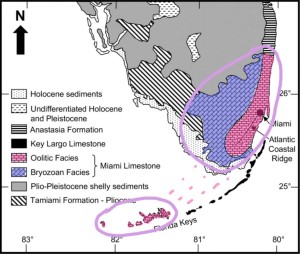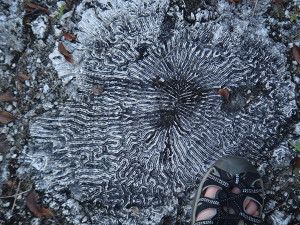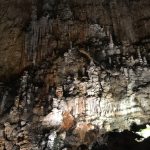This post provides a brief overview of the formation and characteristics of recent limestone deposits in Southern Florida, the Miami Limestone and Key Largo Limestone. Most of this material was collected as part of a presentation for EOS 404S: Geology of Tropical Marine Environments in Spring 2013, but has been expanded and re-formatted here.
I. Common Roots

Image by michaelhallflkeys.
Both the Miami and Key Largo Limestones formed during the Pleistocene due to sea level change, but they were created by different processes/organisms. Basically, sea level was 100 ft higher 125 thousand years ago. Then, 20 thousand years ago, glacier formation caused to sea levels dropped, exposing the reefs and creating limestone islands.
- >100-125 kya
- Interglacial ⇒ higher sea levels (100 ft) ⇒ CaCO3 producers!
- <20 kya
- Glacation ⇒ sea level drops (300 ft) ⇒ exposing reefs ⇒ fossilize
II. Miami Limestone

Image by Neal et al.
The Miami Limestone occurs in the southern part of main Florida and in the southernmost Keys. It consists of two layers, an oolitic facies and a bryozoan facies. The oolitic facies is located near the Atlantic Coast (think Miami), as ooids require energy to form. The bryozoan facies, which only occurs on the Florida main, is located more centrally (think Everglades) because bryozoans prefer quieter waters.
- Oolite: spherical grains of limestone
- Atlantic Coastal Ridge: longshore currents pushed ooids up
- Bryozoans: “tiny moss animals”
- Central: prefer quieter waters
IIA. Oolitic Faces

Photo from SEPM STRATA.
Ooids are small (<2 mm), round, white grains that form when calcium carbonate precipitates around a nucleus (such as a shell fragment); they typically form areas of high wave energy, such as a tidal bar and channel system, where the ooids can be rolled back and forth.
- Well-sorted ooids (grainstone)
- Varying skeletal material (corals, echinoids, mollusks, algae)
- Some quartz sand
- Cross-bedded
- White to orangish gray
- 3-5 m thick (deeper seaward edge)
- “Upper unit”
Ooids

Photo by everybodylovesrocks.
- Form in high energy environment
- “Seed” washed around by waves
- Collects CaCO3
- Eventually buried
- Bigger oolith = “lived” longer
IIB. Bryozoan facies

Image by Halley et al.
Bryozoans are colonial animals that excrete calcium carbonate skeletal structures (similar to coral, but they belong to a different phylum and are more complex, with organs). The species Schizoporella floridana created most of the bryozoan facies in Florida.
- Schizoporella floridana with ooids
- White to orangish gray
- Grainstone & packstone
- Average 10 ft thick, 1 ft on Gulf side
- “Lower unit”
Schizoporella floridana

Photo by GSU.
- Habitat: harbors, bays, mangroves, temperate zone reefs to 50 m in tropical waters
- Colony height 10-15 cm, width 15-30 cm
- Different from coral: more complex (organs), smaller colonies
III. Transition from Miami to Key Largo
- Occurs in southeastern Big Pine Key, laterally at 4-6 m deep over a distance of a few hundred meters

Image by Halley, Vacher & Shinn.

Image by USGS via everybodylovesrocks.
IV. Key Largo Limestone
- Coral in calcarenitic matrix
- Calcarenite: over 50% detrital (transported) sand-sized carbonate grains
- Seaward edge: grainstones
- Gulf edge: wackestones, packstones
- Thickness varies (up to >60 m)
- White to light gray
The Reef: Then vs. Now

Image by Halley, Vacher & Shinn.
- 7 km (5 mi) inward
- 7 m higher sea level
- Main: Montastrea annularis
- More: Halimeda
- Less: Millepora, coralline algae
- No: Acropora palmata
- “Complex of shallow-water shelf-margin reefs & associated deposits along a topographic break”
V. Summary
Miami Limestone | Key Largo Limestone |
|
|
 Photo by FL DEP. |  Photo by FL DEP. |

Image by Halley, Vacher & Shinn.
VI. Resources
- The best concise but thorough resource for the structure and formation of recent Southern Florida limestones can be found in this paper: "Geology and Hydrogeology of the Florida Keys" by Halley, R. B., H.L. Vacher, H. L., and Shinn, E. A. (1997) in Geology and Hydrology of Carbonate Islands. Developments in Sedimentology.
- A physical description of the Miami Limestone by the USGS.
- A physical description of the Key Largo Limestone by the USGS.
- This paper by Haley et al (1977) in the AAPG Bulletin discusses the formation of ooids and the Atlantic Coastal Ridge near Miami.
- This paper by Neal et al (2008) in the Journal of Sedimentary Research has some neat 3D radar-generated maps of the Miami Limestone.
- A discussion of geology in the Everglades can be found here.








